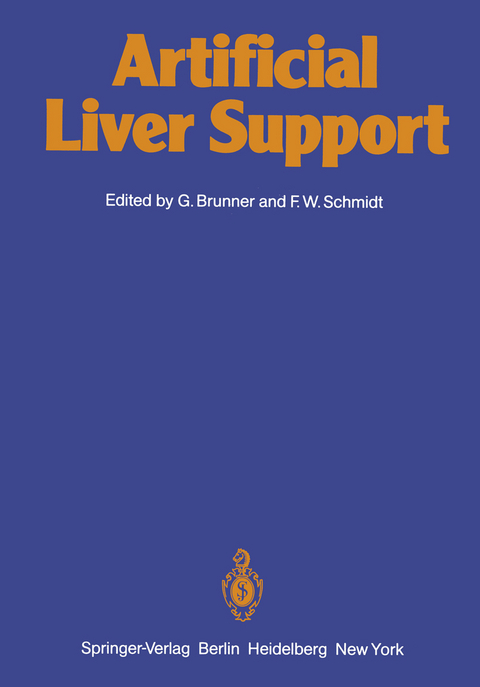
Artificial Liver Support
Springer Berlin (Verlag)
978-3-642-96631-6 (ISBN)
The regenerative capacity of the liver cell is almost unlimited. Therefore after acute liver damage, be it viral, toxic, hypoxic, or surgical in origin, restitutio ad integrum is the usual outcome. In two forms of liver disease, however, this is not the case: in fulmi nant hepatic failure, liver regeneration often is not fast enough to keep the organism alive; in end-stage cirrhosis, regeneration is dis turbed by a hypertrophic architecture of fibrotic tissue. For these extreme forms of liver disease and for critical situations before and after liver surgery, artificial liver support is needed. This book contains the latest results in this area of research pre sented by scientists from allover the world at an international symposium held in Celle, Germany, June 2-4, 1980. Exciting new methods like continuous membrane plasma sepa ration and liver cell transplantation into the spleen have been de veloped. The older methods of hemoperfusion and dialysis have been improved. Enzymological methods and liver transplantation have made good progress. We hope that this volume will help the clinician in his decision-making and stimulate ingenious new re search for the benefit of our liver patients.
I. General Aspects of Hepatic Failure.- Mechanism of Liver Cell Destruction in Fulminant Hepatic Failure.- Enzyme Patterns in Liver Failure.- Synergism Among Toxic Factors and Other Endogenous Abnormalities in Hepatic Encephalopathy.- On the Role of Free Phenols in the Blood of Patients in Hepatic Failure.- The Biochemistry of Hepatic Detoxification.- Determination of Liver Function and Liver Regeneration in Fulminant Hepatic Failure.- II. Hemoperfusion.- The Development of a Haemoperfusion Device for Chronic Use.- A New Charcoal Sorbent Fiber for Hemoperfusion.- Agarose-Encapsulated Adsorbents I. Concept and General Properties.- Agarose-Encapsulated Adsorbents II. Adsorption Characteristics.- Agarose-Encapsulated Adsorbents III. In Vitro Haemocompatibility.- Coating and Blood Compatibility of Amberlite XAD-4.- Development of a Blood-Compatible Resin for Artificial Liver Support.- Middle Molecules in the Serum of Patients and Rats with Liver Failure: Influence of Sorbent Haemoperfusion.- Bilirubin Removal by Sorbent Hemoperfusion from Jaundiced Blood.- Removal of Bile Acids by Various Means of Artificial Liver Support.- Charcoal Haemoperfusion with PGI2 in the Treatment of Fulminant Hepatic Failure.- Hormone Losses by Charcoal Hemoperfusion.- Hemoperfusion, Exchange Transfusion, Cross Circulation, Liver Perfusion, Hormones and Immobilized Enzymes.- Partial Hepatectomy and Subsequent Charcoal Hemoperfusion in the Conscious Rat.- III. Dialysis Procedures.- Large-Pore Hemodialysis in Fulminant Hepatic Failure.- Haemodialysis Procedures in Acute Liver Failure.- Correction of Increased Plasma Amino Acid Levels by Dialysis with Amino Acid-Electrolyte-Glucose Solutions.- Hemofiltration in Acute Liver Failure: Substitution with Electrolyte Solution Versus Normal Animal Ultrafiltrate.- Significance of Hepatic Energy Charge and Blood Ketone Body Ratio as Criteria of Liver Support. Indication and Efficiency in Hepatectomized Patients During Cross Dialysis.- IV. Amino Acid Level Concentration.- Effect of Liver Adapted Amino Acids on Portosystemic Encephalopathy in Patients with Cirrhosis of the Liver and Portosystemic Shunts.- Somatostatin: A New Therapeutic Agent for Treatment of Hepatic Encephalopathy?.- V. Plasmapheresis.- Continuous Flow Membrane Plasmapheresis Utilizing Cellulose Acetate Hollow Fiber in Hepatic Failure.- Augmented Solute Reduction in Diseases Treated by Extracorporeal Detoxification Systems: X-Effect Hypothesis.- Hemoperfusion-Induced Respiratory Distress Syndrome in an Animal Model: The Effects of Corticosteroids.- VI. Enzymatic Support.- Immobilized Hepatic Enzymes as a Tool in Extracorporeal Detoxification.- Immobilization of Ligandin on Hollow Fiber Reactors.- Detoxification of Phenols by Sulphate Conjugation: An Alternative to Glucuronidation in an Enzymatic Liver Support System.- Enzymatic Methylation of Mercaptans: Applicability in an Enzyme Reactor Liver Support System.- Liquid Membrane Enzyme Reactor for Artificial Liver Support.- Advances in the Development of Immobilized Enzymes for Future Extracorporeal Liver Support.- A Model Enzymic Extracorporeal Detoxification System -Part II.- VII. Isolated Liver Cells and Tissue.- Liver Assist by Cultured Cells on Artificial Capillaries.- Hemoperfusion over Small Liver Pieces for Liver Support.- Hepatocellular Transplantation into the Rat Spleen: Transplantation of Hepatocytes Isolated from Cirrhotic Liver.- VIII. Surgical Support.- Treatment of Acute Hepatic Failure by Extracorporeal Hemoperfusion over Human and Baboon Liver.- Experience in the Treatment of Hepatic Comaby Extracorporeal Liver Perfusion.- Functional Capacity of Extracorporeal Baboon Liver Perfusions.- Clearance of Bilirubin and Bile Acids from the Serum of Patients Treated by Extracorporeal Baboon Liver Perfusions.- The Influence of Baboon Liver Hemoperfusion on Serum Levels of Amino Acids and Free Fatty Acids in Patients with Acute Liver Failure.- Surface Redox Potential and Vitality of an Extracorporeal Liver During Hemoperfusion.- The Isolated Perfused Partially Hepatectomised Liver - A Source of Regeneration Stimulator Substance?.- Treatment of Acute Liver Failure by Extracorporeal Baboon Liver Perfusions - Viewed by a Patient.- Liver Regeneration Following Hepatic Resection Without Portal Blood.- Liver Transplantation and Impending Hepatic Failure.- Perspectives of Liver Transplantation in Cambridge.
| Erscheint lt. Verlag | 19.1.2012 |
|---|---|
| Zusatzinfo | XXI, 332 p. |
| Verlagsort | Berlin |
| Sprache | englisch |
| Maße | 170 x 244 mm |
| Gewicht | 620 g |
| Themenwelt | Medizinische Fachgebiete ► Chirurgie ► Viszeralchirurgie |
| Medizinische Fachgebiete ► Innere Medizin ► Gastroenterologie | |
| Medizinische Fachgebiete ► Innere Medizin ► Hepatologie | |
| Schlagworte | abdominal surgery • Hepatologie • hepatology • Lebererkrankung • Leberersatz • Leberfunktionsstörung • Liver • Liver Diseases • Surgery |
| ISBN-10 | 3-642-96631-4 / 3642966314 |
| ISBN-13 | 978-3-642-96631-6 / 9783642966316 |
| Zustand | Neuware |
| Haben Sie eine Frage zum Produkt? |
aus dem Bereich


